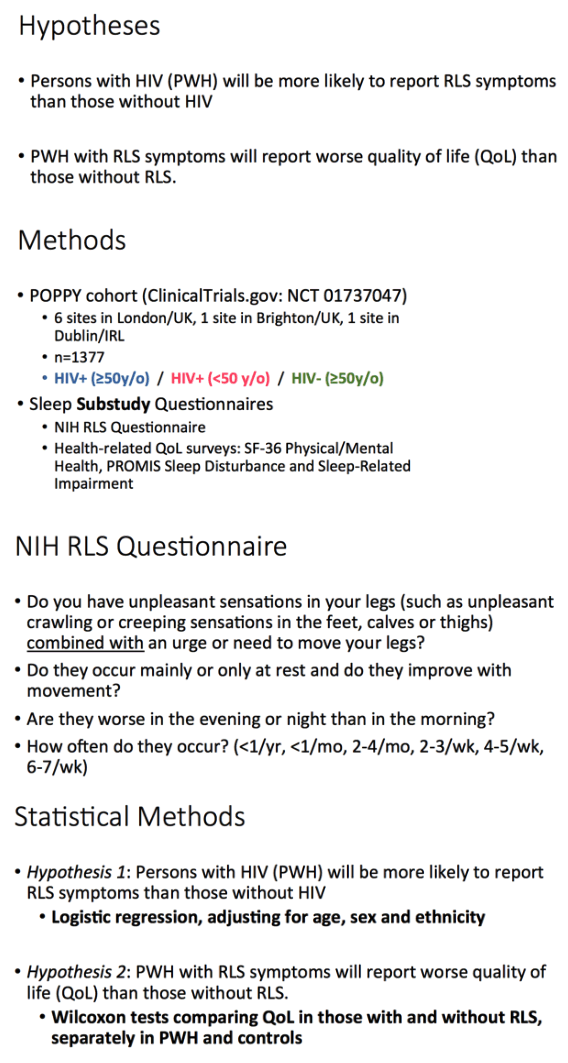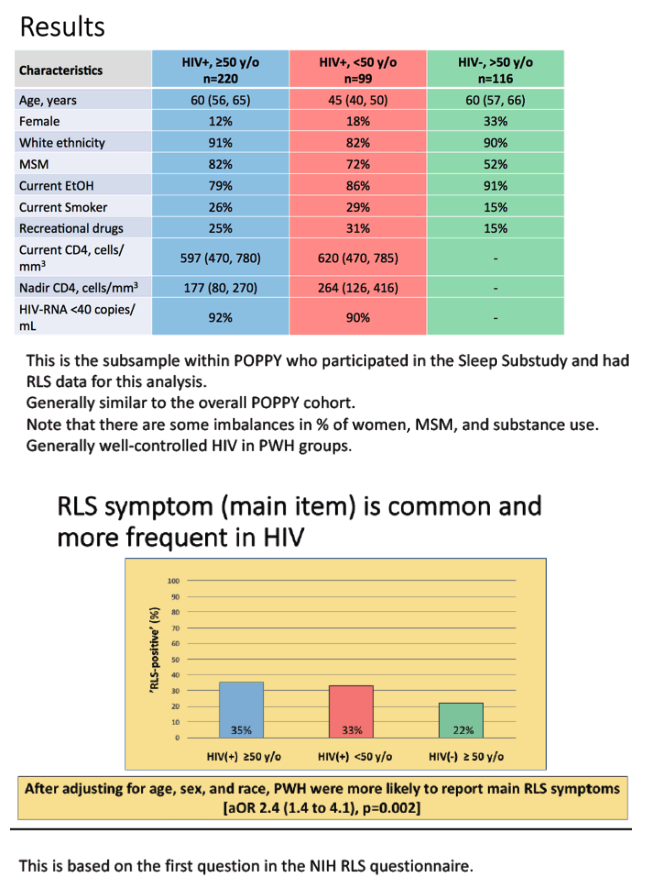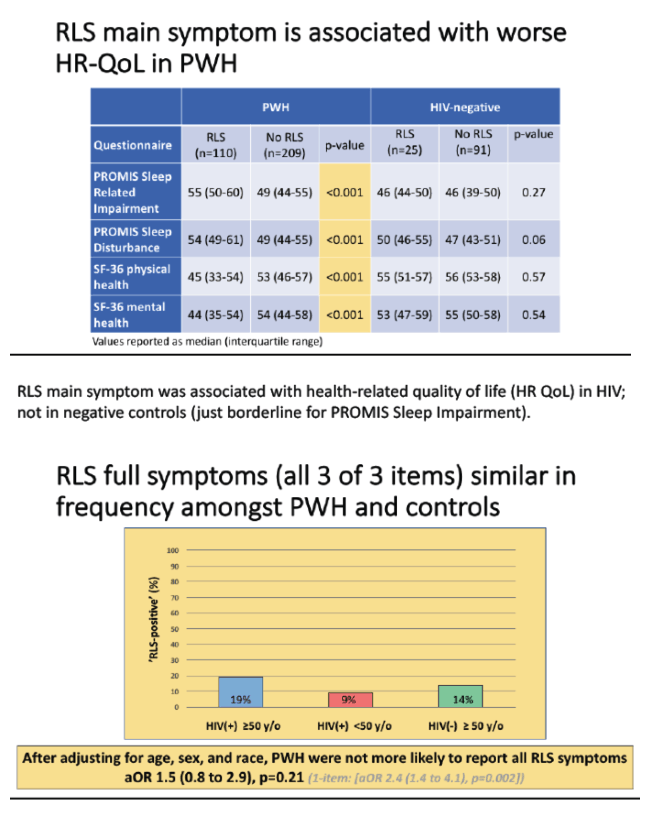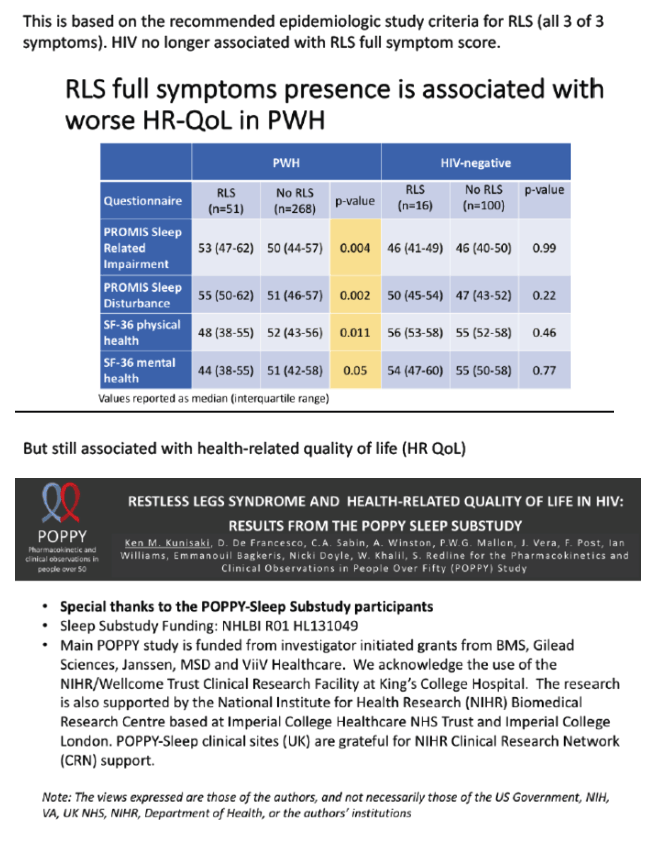 |
 |
 |
| |
Restless legs syndrome and health-related quality
of life in HIV: results from the POPPY sleep substudy
|
| |
| |
https://www.mayoclinic.org/diseases-conditions/restless-legs-syndrome/symptoms-causes/syc-20377168
17th European AIDS Conference, November 6-9, 2019, Basel
Reported by Jules Levin
K. Kunisaki1,2, D. DeFrancesco3, C. Sabin3, A. Winston4, P. Mallon5, J. Vera6, F. Post7, I. Williams3,8, E. Bagkeris3, N. Doyle4, W. Khalil1,2, S. Redline9,10,11, Pharmacokinetics and Clinical Observations in People Over Fifty (POPPY) Study 1Minneapolis VA Health Care System, Minneapolis, United States, 2University of Minnesota, Minneapolis, United States, 3University College London, London, United Kingdom, 4Imperial College London, London, United Kingdom, 5University College Dublin, Dublin, Ireland, 6Brighton and Sussex University Hospitals, Brighton, United Kingdom, 7King's College Hospital, London, United Kingdom, 8Mortimer Market Centre, London, United Kingdom, 9Brigham and Women's Hospital, Boston, United States, 10Beth Israel Deaconess Medical Center, Boston, United States, 11Harvard Medical School, Boston, United States
Purpose: Restless legs syndrome (RLS) is a sleep disorder characterized by leg dysasthesias, typically relieved by movement, with sequelae that may include daytime sleepiness, mood problems, functional impairments, and decreased work productivity. RLS often responds to dopaminergic drugs, suggesting a central nervous system (CNS) etiology. Given the high burden of sleep symptoms and CNS disorders in persons with HIV (PWH), we evaluated RLS prevalence and associations with health-related quality of life (QoL) in PWH and lifestyle-similar HIV-negative controls.
Method: A subset of POPPY participants (PWH ≥50 y/o, PWH < 50 y/o, and HIV-negative controls ≥50 y/o) completed standardized RLS and QoL questionnaires. RLS was defined using international guideline criteria. Sleep-related QoL was assessed with PROMIS questionnaires. Physical and mental health QoL was evaluated with SF-36 scores. Logistic regression was used to compare RLS prevalence in PWH and controls. QoL in those with and without RLS were compared using Wilcoxon tests.
Results: Of 435 participants (220 older PWH (median age 60y), 99 younger PWH (45y) and 116 older HIV-negative (60y)), RLS criteria were met by 77 (35%), 33 (33%) and 25 (22%) of the groups, respectively. In analyses adjusted for age, sex, and race, PWH were more than twice as likely to meet RLS criteria than controls [aOR 2.4 (1.4 to 4.1), p=0.002]. see slides below
Of 110 PWH with RLS (55% of whom reported symptoms at least 2-3 times/week), only 7 (6%) reported a diagnosis of RLS and 3 (3%) reported a history of RLS medication treatment. PWH with RLS reported worse sleep-related QoL and poorer physical and mental health QoL compared to PWH without RLS (Table, all p's < 0.001).
Conclusion: Among PWH, RLS is common, associated with health-related QoL impairments, and rarely diagnosed or treated. Further research is needed to understand risk factors for RLS and the effects of RLS treatment.






|
| |
|
 |
 |
|
|